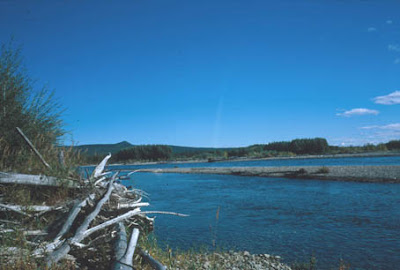When working with wobbler flies (see the post dated January 12, 2010), I had made several ones with a blade put “wrong way” - it was directed to the water surface. Here you can see "normal" wobbler-fly (bottom) and Anti-wobbler (top).
What did I want to get? Just a new type of a surface skater. When I was testing them in the water, some of the flies with an upright blade were showing much more complicated behavior than just coming to the surface and skating. Some of the sinking varieties during retrieve had characteristic “hunting” movements – wide sweeping action. These were the flies of completely new type.
The base of Anti-wobbler consists of a hook and plastic blade; attached with 0,1 mm mono line & clear glue. The best blades are concave ones; I make them out of disposable syringes. When the glue will be dry, you could built on this hook with a blade any fly: streamer, imitation of squid, prawn, leech, or insect larva.
On this simple base you could tie Anti-wobblers of 3 main types: 1- with a foam back, 2 - Matukka style with a back out of a feather, and 3 - the simplest fly which has only hook, blade, body & tail. All 3 flies below imitate little Cyprinid fish; I use them for catching pelagic predators in the Amur River.
Anti-wobbler is excellent choice for catching pink salmon in the Sea of Okhotsk, far from fresh water.
This fly was most effective on that day - yellow skinny Anti-wobbler.
Anti-wobblers were catching pink salmon in the river as well.
Fresh silver pink salmon often jumps when feeling a hook.
School of salmon running up Ola River near Magadan
Sunset at the Amur River. Anti-wobbler could be presented near the bottom, in the middle layers of water, under the surface, and on the surface as a skating fly.
On the base of Anti-Wobbler (blade & hook) you can tie any streamer, fantasy fly, leech, or nymph. The tail is usually made out of marabou or soft synthetics, sometimes with some flashy fibers. Comparing with normal wobbler flies, anti-wobblers do not need the buoyant foam back; many of them I make with no foam at all.
Anti-wobbler is one of the best flies for skygazer from the Amur River.
On some days this strange fly works much better than any spinning lures.
Fine-tuning of the Wobbler flies and Anti-wobblers is done same way: by cutting the blade. It is necessary to get flies with a stable wiggling action on retrieve. A good fly is not falling on one of the sides, and is not rotating even on strong current.
There is one more option – using a floating Anti-wobbler with foam back with sinking line in shallow areas. The line goes on the bottom, and the fly is moving above it. This is one of the best approaches to predators of big rivers.




































